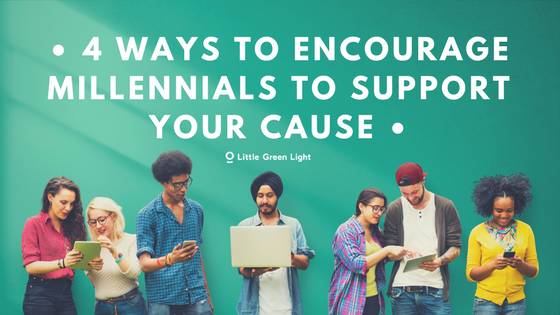Little Green Light is a cloud-based donor management system for fundraisers.
Subscribe to get our latest product updates, best practices and tips to grow your nonprofit.

I worked at a library during graduate school, and one of my tasks was to shelve the periodicals and keep them in order. I couldn’t stop myself from paging through the newspapers and magazines as I (slowly) completed this task. Plenty of articles tried to make sense of a generation that was clad in hoodie sweatshirts well past college, spent an absurd amount of money on cups of coffee, and seemed to resist the concept of growing up. Think I’m talking about millennials? Nope! At that time, Generation X was causing everyone to scratch their heads.
Every generation has its own nuances. Millennials, born between 1983 and 2000, are the generation du jour. According to Generations Theory, which is the idea that four types of generation have come into being in the United States in the past 100 years, millennials are identified as a civic generation of cooperative leaders, team players, and institution builders.
With that in mind, there are certainly strategies that nonprofits can employ to engage millennials. The following ideas can help your organization reach millennials and bolster your efforts to reach other age groups as well. Above all, remember: millennials are people too.
The median millennial graduated from college during the financial crisis of 2008. That, coupled with their high burden of student loan debt, means it may be a while before the average millennial can be a significant financial donor. But millennials aren’t afraid to roll up their sleeves for a good cause. Volunteer opportunities give millennials a chance to get to know your organization and support your mission with their time and energy. By harnessing millennials’ desire to be involved, you can groom a generation of donors who understand the inner workings of nonprofits—not to mention future board members and leaders who are eager to be hands-on.
Millennials’ loyalty lies with causes, not necessarily with specific organizations. You’ll resonate with millennials if your communications consistently connect your organization’s work with a broader cause and the impact of your work. If you work for a local food pantry, demonstrate how your organization is working locally as part of the broader effort to fight hunger in America. Consider swapping out the traditional, lengthy “Letter from the Director” in your annual report for a story about the direct impact of your efforts, and include images. Concise success stories will inspire millennials to donate, volunteer, or share the message with their friends.
Locally sourced food, handmade items, micro-breweries, small-batch anything and everything…millennials love a local connection. Just as it’s important to connect your organization’s work to a broader cause, it’s important to emphasize your local impact. For example, a historic preservation organization can connect its own work to new preservation ideas and techniques that are being explored at the national level. Give examples of how you’re using these techniques on historic properties in your own community. Share what makes the work you’re doing unique to your town, and how the local economy and community are improving because of it.
Just because millennials are tech-savvy doesn’t mean they won’t welcome an actual thank you letter in the mail. In fact, your thank you card may make an even bigger impression on a millennial simply because so much of their communication is electronic. Whether you’re thanking them for a donation or for volunteering, make an effort to connect with millennials personally. Implement a strategy to thank them and welcome them as new donors when they make their first gift, no matter the size of it.
As mentioned earlier, keep in mind that millennials are people too. While it’s important to take their unique perspectives and preferences into consideration, these tips for reaching them will help you connect with donors from other generations as well. Similarly, the same consideration and good old-fashioned manners that you show your Baby Boomer donors will be appreciated by all your supporters, no matter their generation. Want to learn more about what makes each generation tick? Check out our blog post on Generations Theory.
Full disclosure: Depending on which definition of millennials you refer to, my birth year places me at the tail end of Gen X, the very beginning of millennials, or straddling the two generations. This means that while I collected a fair number of “You’re great just for participating!” certificates in elementary school, I also twirled the cord of a rotary phone around my finger while chatting with friends and I used actual pen and paper to write to pen pals.
Ready to try LGL? Get your first 30 days free. No credit card required.